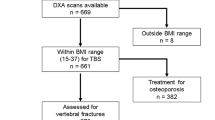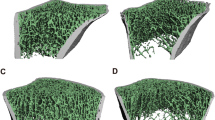Abstract:
Despite an intriguing understanding of trabecular bone dynamics, little is known about corticosteroid-induced cortical bone loss and fractures. Recently, we verified a steroid-induced decrease in cortical bone volume and density using peripheral quantitative computed tomography (pQCT) in adult asthmatic patients given oral corticosteroids. Subsequently, the pQCT parameters and presence of vertebral fractures were investigated to further clarify the role of cortical bone quality in fractures in 86 postmenopausal (>5 years after menopause) asthmatic patients on high-dose oral steroid (>10 g cumulative oral prednisolone) (steroid group) and 194 age-matched controls (control group). Cortical and trabecular bone was subjected to measurement of various parameters using pQCT (Stratec XCT960). Relative Cortical Volume (RCV) was calculated by dividing the cortical area by the total bone area. Strength Strain Index (SSI) was determined in the radius based on the density distribution around the axis. Spinal fracture was assessed on lateral radiographs. Patients treated with high doses of oral steroid (>10 g cumulative oral prednisolone) were found to have an increased risk of fracture compared with control women receiving no steroid medication (odds ratio, 8.85; 95% CI, 4.21–18.60) after adjustment was made for years since menopause, body mass index and RCV. In both groups, the diagnostic and predictive ability of the pQCT parameters for vertebral fracture was assessed by the areas under their receiver operating characteristic (ROC) curves. All parameters were found to be significant predictors (p<0.0001) in the control group. In the steroid group, however, the cortical bone mineral density (BMD) (p= 0.001), RCV (p<0.0001) and SSI (p= 0.001) were found to be significant predictors, but not trabecular BMD (p= 0.176). For comparison between the two groups, thresholds of all parameters for vertebral fracture were also calculated by the point of coincidence of sensitivity with specificity in ROC testing and the 90th percentile value. Although a rise in fracture threshold in the steroid group was suggested, considerable difference in the values obtained by the two methods of calculation precluded any conclusion. High-dose oral steroid administration was associated with an increased risk of fracture. Cortical bone parameters obtained by pQCT could play a role as good predictors of future corticosteroid-induced vertebral fractures.
Similar content being viewed by others
Author information
Authors and Affiliations
Additional information
Received: 30 November 2001 / Accepted: 28 February 2002
Rights and permissions
About this article
Cite this article
Tsugeno, H., Tsugeno, H., Fujita, T. et al. Vertebral Fracture and Cortical Bone Changes in Corticosteroid-Induced Osteoporosis. Osteoporos Int 13, 650–656 (2002). https://doi.org/10.1007/s001980200088
Published:
Issue Date:
DOI: https://doi.org/10.1007/s001980200088




